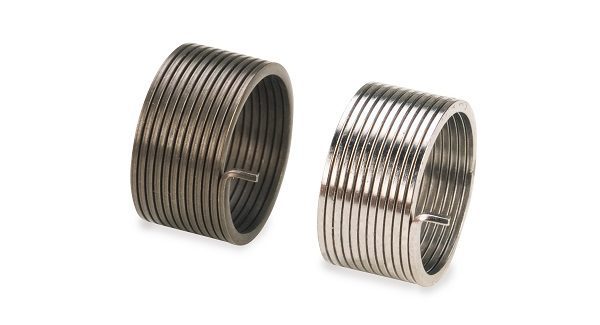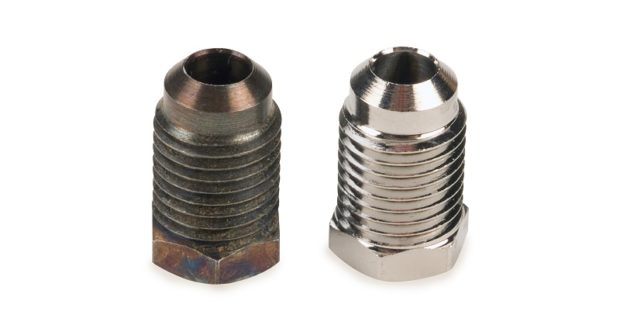Stainless Steel Finishing: What You Need to Know
Understanding the specific alloy and how it will interact with different finishing processes can help guide you to choose the best finishing method for your application. Here are four key factors to keep in mind when finishing stainless steel.
Posted: April 17, 2017
Electropolishing is an effective and recommended finishing technique for stainless steel parts, both on its own and in conjunction with other finishing processes. When parts are properly prepared, the electropolishing process can provide a uniform finish that is free from burrs and resist patterns from scale.
(1) “STAINLESS STEEL” ISN’T 100 PERCENT STAINLESS OR PASSIVE
Contrary to what the name implies, stainless steel can be subject to rusting and corrosion under the right circumstances, and without the proper finish. Although stainless steel is naturally passive, its passive state can be compromised when coming into contact with contaminants during machining and subsequent secondary operations. A passive metal is one that easily forms an oxide film over the surface that then protects the metal from oxidation and corrosion. Contamination can occur when stainless steel parts come into contact with carbon steel tooling or other exogenous matter that is present in a shop atmosphere.
(2) PREPARATION IS KEY TO A SUCCESSFUL OUTCOME
Prior to subjecting metal parts to a final finishing process, parts frequently need to undergo some sort of preparation stage to achieve best results. Stainless steel is no exception to this rule: regardless of the finishing method, a failure to properly prepare the parts for finishing will compromise the result. For example, a common issue that must be addressed in metalworking projects is deburring – the process by which the “burrs,” or unwanted pieces of metal extending beyond the part’s dimensions, are removed. A finishing method such as electropolishing is effective in removing smaller micro burrs, but any macro deburring should take place prior to electropolishing. Depending on the height and width of the burrs that are present, a part may require a conventional deburring process, such as vibratory finishing, before electropolishing.
In addition, parts that have been welded or heat treated and exhibit heavy scale may need to be mechanically cleaned prior to electropolishing. When parts are properly prepared, the electropolishing process can provide a uniform finish that is free from burrs and resist patterns from scale.
(3) UNDERSTAND THE LIMITATIONS OF PASSIVATION
Passivation is a chemical cleaning process that is designed to remove free iron and other superficial contaminants, returning the part to its original mill condition. It is typically the minimum recommendation for finishing stainless steel parts, but may not be adequate for warding off corrosion. Achieving a successful passivation treatment will depend upon several factors, including the specific composition: some stainless steel alloy compositions, like 440C and 416, are not suitable for passivation. The lower levels of chrome and absence of nickel make these alloys prone to flash attack, which can cause roughness and pitting on the surface of the part, darkening and etching the very surface that the passivation treatment was intended to protect.
In cases where environmental factors will expose a stainless steel part to an increased risk of corrosion, additional corrosion resistance may be necessary with electropolishing. Electropolishing is the ideal method to prolong the life of parts. In fact, accelerated corrosion testing has demonstrated that electropolishing provides 30 times the corrosion resistance when compared to passivation alone.
(4) KNOW YOUR OPTIONS AND THE RESULTS THEY PRODUCE
Electropolishing is an effective and recommended finishing technique for stainless steel parts, both on its own and in conjunction with other finishing processes. Some of this popularity can be attributed to the way that electropolishing achieves the desired effect of other processes, but with fewer pitfalls. Three of the most common stainless steel finishing options are:
- Vibratory Finishing. This process typically entails the use of a vibratory bowl, soap lubricants and a variety of polishing media. The media will vary depending on the size of the part, rigidity of the part and what you are trying to achieve with the process. The most common use for vibratory polishing is to remove sharp edges, macro burrs and other surface irregularities. While often effective, this process is not designed for fragile parts that can easily become distorted.
- Mechanical Polishing. The process of mechanical polishing involves metal being both moved and smeared using abrasive wheels and belts with polishing compounds containing various grit sizes. Not only is this a costly option, it is also time-consuming and creates problems in maintaining a consistent high degree of precision. Since electropolishing removes the outer layer of metal electrochemically, it is significantly easier to achieve a uniform surface from part to part and lot to lot.
- Blasting. Blasting is another commonly used secondary operation and finishing technique. The process consists of bombarding the material’s surface under high pressure with glass beads, aluminum oxide, sand, and other media. While this can be effective in removing residual scale from cast and heat treated metal surfaces, there is always the risk that the media being used may not cut deeply enough into the surface, resulting in defects and imperfections being covered over rather than eliminated. Due to the nature of the blasting process, the metal surface will become contaminated with the media when the surface is impinged. Additionally, blasting creates a rough, matte surface finish that necessitates the use of another finishing operation, such as electropolishing, to achieve the final bright, smooth and clean finish.
Stainless steel is a practical, cost-effective option for a variety of metal parts across countless industries. Choosing the right finishing process can provide your stainless steel part with both the desired appearance and reliable performance that your application requires.

















